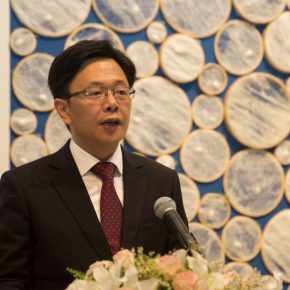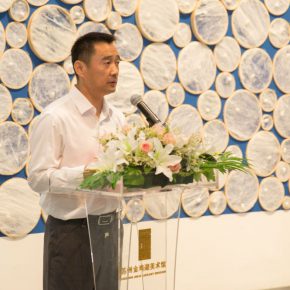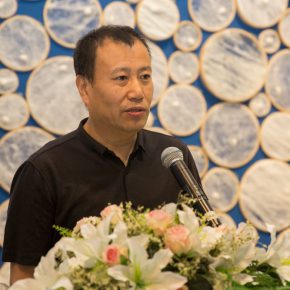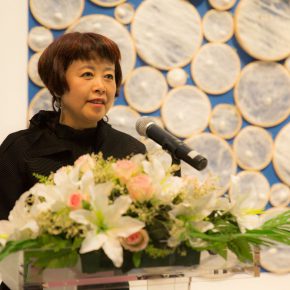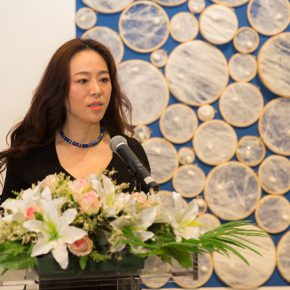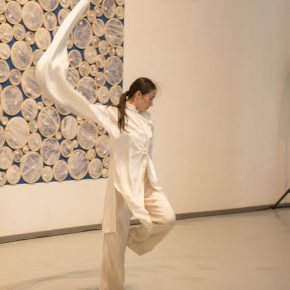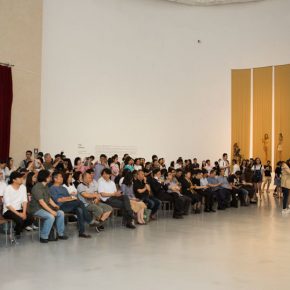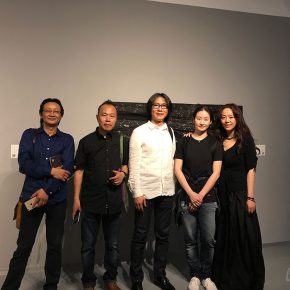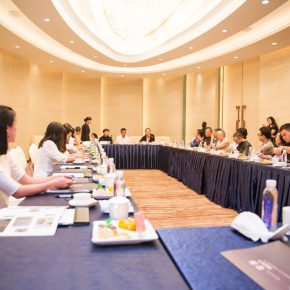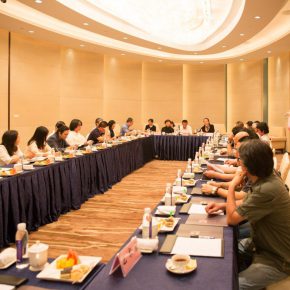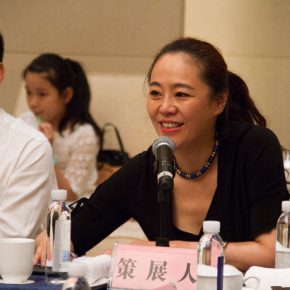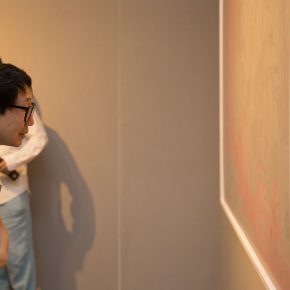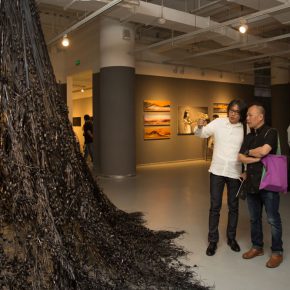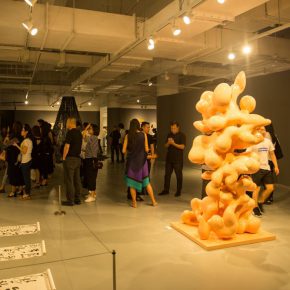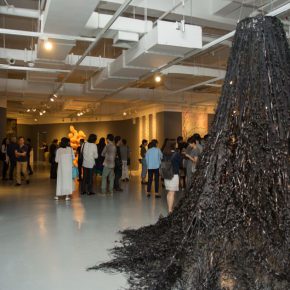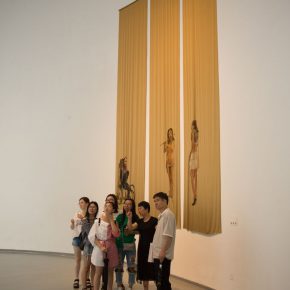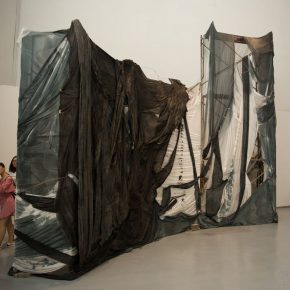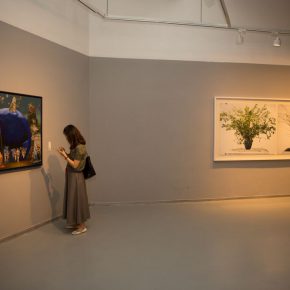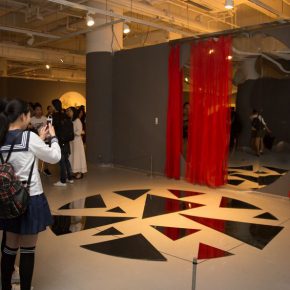
It was on a day during the rainy season in the Regions of the South of the Yangtze River in 2017, a silk-themed contemporary art exhibition started in Suzhou Jinji Lake Art Museum. Suzhou has been a silk town since ancient times, so it has an extraordinary significance in holding an exhibition in the city. The exhibition invites more than thirty contemporary artists to use their ingenuity, imagination, and a variety of artistic techniques to show the fresh vitality of silk in contemporary aesthetic and creative areas, around the evolution, cultural symbols and life connotations of Chinese silk. How does the Silk Civilization that has been precipitated for thousands of years, inspire contemporary artists to create? How do the artists break through the self-spirit cocoons to finish a physical reincarnation? How do the traditional regional cultural elements continue, change and gain a wide cultural identity? The exhibition is concerned with these academic topics.
Silkworm culture was originated from Suzhou, as early as in the Zhou Dynasty, 1000 BC. Chinese ancestors were engaged in planting mulberry, sericulture, silk reeling and satin weaving, this started with the silkworm’s ecological changes to introspect the reincarnation of life and this association has become the initial premise for silk to create a differentiation and development in China – being closely related to people’s “view of life and death” at that time. In the beginning, silk fabrics were used to wrap corpses, in order to achieve the “aspiration of soaring and the regeneration of the soul”, which has a profound impact on classical Chinese philosophy and the order & concepts. After the silk industry had been increasingly developed, the silk became high-level clothing that was affordable to prestigious nobility and a set of ritual system corresponded to their identity, rank and official title which was derived from the silk which has represented luxury since ancient times. Silk has an impact on Chinese art, which is reflected in the carrier of Chinese painting – brocade and raw silk, which were considered as major materials for writing and painting, started from decorative patterns then moved to literati painting. The texture and storage of silk fabrics both influenced the expression of the brush and ink of the ancient artists of Chinese painting and calligraphy.
Borrowing Implications and Connections: Considering “Loom” as the Title
A loom refers to a weaving machine. The word “loom” originated from the sentence of “Rather than hearing the voice produced by the working loom, Mulan’s signs were heard”, from the earliest Collection of Poems of Yuefu the “Poetry of Mulan”. It uses Loom as the title, both borrowing the implication of the silk image and also the connection and extension of a variety of contemporary methods of creating – “It stems from the loom”, borrowing its implication of “ingenious and unique ideas and layout”.
At the same time, the curator Zhang Yanzi also has her own elaboration on this topic and said that, the Chinese character “Ji” (machine) represents life, timing and opportunity in Chinese culture, and it also brings the artists an opportunity to explore the philosophy behind silk culture, as a creation with a “passive” proposition, and it was also a type of “Ji” (chance). In her view, contemporary art and “weaving” have a similar meaning at a certain level and the artists are influenced by a variety of effects from culture, society and life, when these things become the genes of the creators, what they see, what they feel, what they think and their ideals can be woven into their own works of art.
In addition, the curator Lyu Yue addressed the opening ceremony and said that, the fabric involving longitude and latitude was formed by warp and weft. In this exhibition, the warp can be called the historical context of silk culture which started from collecting wild silkworms to weave silk in ancient times, to the later planning mulberries and sericulture, from the funeral customs to the development of silk cultivation, sifting through the history of thousands of years we find it has a long story. The weft is from daily life and creates the artistic expression, in this exhibition, many artists worked together in the creation, and many artists have closely linked their latest works to the topic of loom. The intersection of latitude and longitude is in Suzhou, and to be precise it is in Jinji Lake Art Museum. This silk-related art returns to the birthplace of Suzhou embroidery and Song brocade, returning to the location during the prime time of silk culture, which is an important node for the contemporary art exhibition. Weaving the “brocade of art” is the intention of the Loom exhibition.
Cocoon-Break and Reincarnation: Contemporary Transformation of Oriental Philosophy
The artists participating in this exhibition present works covering almost all categories of contemporary art, painting, sculpture, installation, video, concepts as well as other cross-border works including sound and dance. To demonstrate the thinking and expression of the theme, the artists started from the personal context of language, with a variety of styles for conversion. Looking through the works, it can be divided into five paths of expression.
Firstly, some of the artists focused around the evolution of the life form of silkworms to develop a narrative, starting from the cultural symbol stage of the “cocoon-break”, “a cocoon turns into a butterfly”, the participating artists include Xu Bing, Liang Shaoji, Lyu Yue, Qiang Yong, Gao Qian, Wu Hua and so on, who all create a rich performance at various stages of the life of a silkworm, the ancient oriental philosophy has been processed and converted by contemporary art, to become a considerable, audible, fragranced and touchable work which encourages far reaching thoughts by the audience. The second category of artists, such as Lin Yan, Zhang Yanzi, Qiu Zhijie, Xu Lei, Jiang Jie, Xu Weijing, Wang Yao, etc., started from the perspective of life, nature, science and even the perception of the cosmic world, to express a respect for life and nature, as well as the relationship between the individual and society, the material and the spirit. The third category of artists, such as Liu Qinghe, Yu Hong, Qi Mengguang, Zhang Jian, and Jin Xiaoyao, focus on the performance of silk material or the study of silk culture, they have a personal exploration of language in the materials and the theme of silk from the perspective of easel painting. Additionally, some of artists are more inclined to tradition, whether it is the theme of the works or the making and composition of works, they all involve the traditional factors and clues. For example, Wei Jia, Li Chaode, Fan Weiyan, Jiang Zhusong, Li Ronglin, Xiao Suhong, Yuan Mingxin, Yao Yongqiang, Zheng Weiren, Zhu Wei and other artists. Furthermore, some of the artists have a multi-dimensional interpretation of the cross-border interaction in the framework of silk culture, including Zhu Zheqin, Wang Yabin, Younger Siqin Gaowa, who have identities as a singer, dancer and actor, to interpret their understanding of this subject from their own perspective.
“Born in the cocoons and finished by a loom” – recorded in the Book of the Later Han, became a vivid and appropriate portrayal of the exhibition. Looking back at the traditions, it is only a starting point for this exhibition so through awakening the inherent impressions of the “silk and its culture” in the mind, it brings the artists and spectators a chance to break the bondage and have a self-unlocking. As a contemporary individual, people can see themselves in this new visual baptism, to finish the decoding and coding by themselves.
Text by Zhu Li, translated by Chen Peihua and edited by Sue/CAFA ART INFO
Photo by Hu Sichen/CAFA ART INFO


